Designated A Historic Landmark Of Agricultural Engineering The Massey-Harris No. 20 was the First Commercially- Successful Self-Propelled Combine Used to Harvest Small Grains Under a Wide Variety of Conditions, World-Wide. Engineered By Thomas Carroll, Chief Engineer, Aided by Robert Ashton and Albert Luke, Principal Assistants, it was First Marketed in 1938 by the Massey-Harris Company. This Combine Opened a New Era an Farm Mechanization and Revolutionized the Grain Harvesting Process. Forty-Four Years Later, This Same Harvesting Principle Continues to be Used Throughout the World.
ASABE

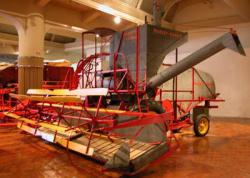
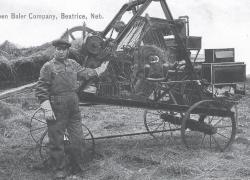
Luebben Hay Baler - Historic Landmark of Agricultural Engineering. In 1892, Hugh Luebben from Sutton, Nebraska, with sons Melchior and Ummo built a mobile machine to produce round hay bales between two sets of rotating flat belts. They began manufacturing the baler in 1909 in Beatrice and later moved to Omaha, Nebraska. Allis-Chalmers purchased the patent in 1939 and eventually sold 77,200 "Roto-Balers." The Luebben baler made handling easier, improved hay quality, and reduced costs. The same basic design is used on modern large round balers.
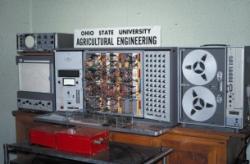
The first laser grade control was developed by agricultural engineers James Fouss and Norman Fausey of USDA's Agricultural Research Service at The Ohio State University in the mid-1960's. That system controlled the precise depth and grade of subsurface drains by regulating trenching and plow-type drainage machines. Photo cells mounted on the drainage machine automatically raised and lowered the digging device, keeping the cells centered on a laser beam set to the desired elevation and grade.
matic grade‐control system on the plow.

On this site in 1837 John Deere built the first successful self-scouring steel plow, thereby making a significant contribution to the development of American agriculture. Dedicated by American Society of Agricultural Engineers 1976
In 1926, Ives Hall, the original Agricultural Engineering Building at The Ohio State University, Columbus, was designated as ASAE's first engineering landmark in honor of department founder and 18th president of ASAE Fredrick Walter Ives. Frederick W. Ives 1884 - 1924.
Ives Hall was on the corner of Neil and Woodruff Avenues from 1926 - 2002. This display has been constructed with brick from the original structure.

In 1892, John H. Froehlich, Froehlich, IA, Mounted A Gasoline Fueled Internal Combustion Engine On A Traction Geared Frame And Used It To Power A Threshing Machine. A Change In Power Source Had Begun On North American Farms. In 1892, The Case Co., Racine, Wi, Built An Experimental Gas Traction Engine. In 1898 A Patent Was Issued To The Van Duzen Co. Cincinnati, OH, For A Gasoline Traction Engine. Huber Mnfg., Marion, Oh, Bought This Patent In 1898 And Produced 30 Prototype Units. In 1902, Hart-Parr, Founded By Charles W. Hart And Charles H.

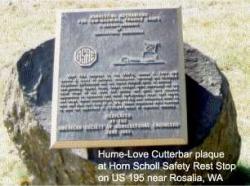
Near This Location In The 1930's James E. Love And Horace D. Hume Of Garfield, Washington, Invented The Flexible Floating Cutterbar And The Tined Pickup Reel To Harvest Low-Growing, Fragile Crops. These Devices Were Developed For The Local Crops Of Dry Peas And Lentils And Were Then Adopted Nationwide To Soybeans And Other Low-Growing Crops That Tangle And Lodge. These Mechanisms Reduced Dry Pea Harvesting Costs By 28% And Crop Loss From 50 To 10%. These Inventions Were Reported To Save The Equivalent Of 2,750,000 Acres Of Soybeans Annually.
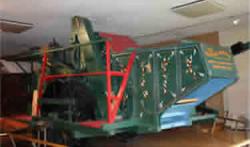
The Sidehill Combine Developed By The Holt Brothers At Stockton, California In 1891, A Significant Milestone In Grain Harvesting And Agricultural Efficiency That Opened New Land For Wheat Farming, Is Designated A Historic Landmark Of Agricultural Engineering By The American Society Of Agricultural Engineers 1982
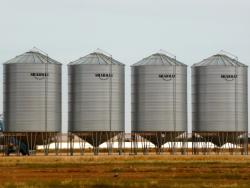
Tests Of Grain Aeration To Cool And Dry Combine-Harvested Wheat By F. L. Fenton, C. O. Swanson, And Orval C. French At Kansas State University In 1930-31 Showed Mechanical Ventilation To Be More Effective Than Natural Draft Ventilation. Mechanical Aeration Was Further Developed In The 1940's To Prevent Moisture Migration, Which Caused Wetting And Spoilage Of The Top Layers Of Stored Grain. Studies In 1944-45 By Usda Agricultural Engineers G. W. French And W. V. Hukill Cooperating With Iowa State University Proved That Mechanical Aeration Prevented Moisture Migration. G. H.


